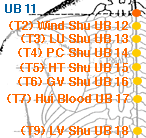UB 13
Acupuncture Point Theory
UB 13 Acupuncture Point Applications and Theory
 The acupuncture point "UB 13" , 肺俞, is represented by "Fei Shu" in pinyin and "Lung Shu" in english and may be found:
The acupuncture point "UB 13" , 肺俞, is represented by "Fei Shu" in pinyin and "Lung Shu" in english and may be found:
1.5 cun lateral to GV 12, level with T3.
Of many possible clinical applications, it may be considered to influence the following issues/symptoms:
- Main point for all Lung related issues from a TCM perspective - tonifies LU Qi and Yin: cough, asthma, bronchitis, sore throat, nasal congestion, shortness of breath, weakness of the voice, consumption, steaming bone disorder, etc.
- Useful for skin disorders, itching, acne, hives, etc.
- Lung related emotional imbalances such as grief and sadness.
- Qi tonification aspects can be increased with the application of moxabustion at this point.
Ub 13 has the following theoretical associations which serve as important guideposts in designing an effective treatment protocol:
Explore ub 13 functional grouping theory - MuShu, or read all point categories and related theory.
A single acupuncture point is not commonly thought of as an empirical way to influence a TCM diagnostic pattern. UB13, however, is a strong candidate to be incorporated into an acupuncture protocol for patients who exhibit: Lung Qi Deficiency and/or Lung Yin Deficiency
UB 13 may potentially be used, in coordination with a well designed acupuncture treatment protocol, to influence the following conditions: Asthma, Cough, Depression and/or Steaming Bone Disorder
While not necessarily valid clinically, EX Huatuojiaji at T3 (T3 innervates the lung and lymph systems and is u…), GV 12 ( Heat in the lungs and chest, cough, asthma, c…), SI 9 (Local point for shoulder and arm pain and/or move…), SI 11 (Breast problems, mastitis, insufficient lactation…) and UB 42 (Reinforce the Lung Shu (UB 13) for Lung related d…) are nearby.
All Content 1999-2025
Chad J. Dupuis / Yin Yang House
Our Policies and Privacy Guidelines
Our Affiliated Clinics
